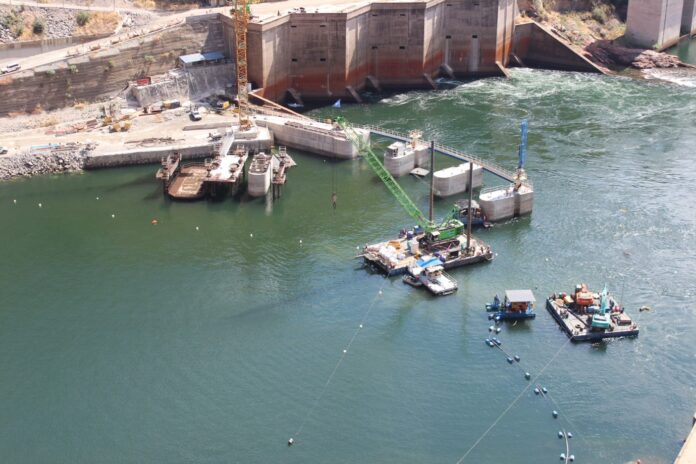
Sydney Kawadza
Zimbabwe and Zambia should expect spending millions of United States dollars in regular repairs, rehabilitation and maintenance at the Kariba Dam, which has reached an advanced age of 60 years.
The aging dam, which is one of Africa’s largest inland dams, is now susceptible to risks such as climate change.
The two Southern African countries have mandated the Zambezi River Authority, a bi–national organization, to sustainably harness the hydropower potential offered by Zambezi River for socio-economic and industrial development.
ZRA has, from 2015, been working on a project aimed at enhancing the structural integrity of the Kariba Dam wall for efficient power generation for the benefit of Zimbabwe and Zambia and the Southern African region.
According to a recent research study by the United Nations University’s Institute for Water, Environment and Health, dams like Kariba could be “risk, and costly” to remove despite their advanced age.
In the report titled “Ageing Water Storage Infrastructure: An Emerging Global Risk”, it is noted that every infrastructure has a design life and ageing is a normal process.
“Dams like Kariba will likely continue to operate much longer with recurring investments into repairs despite the advanced age of 60 years by now, as they may be simply too large, risky, and costly to remove,” the report says.
It states that an average life expectancy of a dam is 50 years with dams constructed between 1930 and 1970 having a design life of approximately 50-100 years.
“Others suggest the service life of well-designed, well-constructed, and well-maintained and monitored dams can easily reach 100 years, while some dam elements (gates, motors) may need to be replaced after 30 to 50 years.”
All modern dams, the report says, must meet safety regulations that typically model and examine scenarios of failure up to 100 years.
“An arbitrary age of 50 years is used as the point when ‘a human-built, large concrete structure such as a dam that controls water would most probably begin to express signs of aging.’
“These ageing signs may include increasing cases of dam failures, progressively increasing costs of dam repair and maintenance, increasing reservoir sedimentation, and loss of a dam’s functionality and effectiveness. These manifestations are strongly interconnected.”
The report also states that many large dams worldwide have reached or are approaching the lower bound – 50 years – of their anticipated lifespan.
“Overall, dam ageing appears to be gradually emerging as a development issue faced by many countries. Yet, it has not been comprehensively assessed globally or accounted for in future water storage infrastructure planning,” it further states.
Co-author and institute director Vladimir Smakhtin was quoted by IFP saying; “This is an emerging global risk that we are not yet paying attention to. In terms of dams at risk, the number is growing year by year, decade by decade.”
The Kariba Dam is a concrete arch dam 128 m in height that impounds the Zambezi River between Zimbabwe and Zambia and as of 2015, was the largest man-made reservoir in the world impounding 181 km³ of water.
During its construction, about 15,000 individuals were relocated from the reservoir footprint and was completed in 1960 to cover the electricity demand of the Zambezi river basin region.
The report further states that about 35 percent of the basin’s hydroelectric capacity originates at the Kariba Dam, making it an essential source of energy for the region.
It holds a total capacity of 1830mW, according to the World Bank, and in 2015, the South African Institute for Risk Management identified that the Kariba Dam needed urgent repairs after its floodgates eroded a plunge pool at the dam’s base, very close to its foundation.
The UN report further states that erosion can potentially weaken the dam’s foundation and could lead to its collapse adding that repairing the spillway was deemed necessary to maintain the dam’s stability.
“A failure of the Kariba dam would be catastrophic and would also cause the collapse of downstream Cahora Bassa dam. This would impact over three million individuals, and the population’s electricity needs would no longer be met,” the report says.
Kariba Dam is being repaid at a total cost of US$300m through a loan with work expected to be completed by 2024.
Meanwhile, according to the ZRA chief executive Engineer Munyaradzi Munodawafa, the on-going Kariba Dam Rehabilitation Programme works comprise two components – reshaping of the Plunge Pool and refurbishment of the Spillway Gates.
“The reshaping of the Plunge Pool involves excavation of the rock in the pool in order to increase the pool volume and thereby minimising erosion which can undercut the dam foundations. The existing pool was created by spilling water immediately downstream of the dam wall.
“The works required to reshape the plunge pool (include) construction of a downstream cofferdam to enable the blasting; and excavation of an estimated 300,000 m3 of rock from the downstream end and north and south bank sides of the pool in the dry.
“This will create a new pool profile that will dissipate the energy of the water jets from the flood gates to non-erosive levels as well as reducing turbulence by guiding the spilling water in the downstream direction and hence avoiding any backward erosion towards the dam foundations in the process.”
Re-shaping started in May 2017 and is targeted for completion before the end of 2024 works currently at 60 percent complete.
The Spillway Refurbishment started in September 2019 and is expected to be complete in 2024.
The works are aimed at ensuring free movement of the gates used to shut the upstream opening of the flood gates during maintenance of the flood gates while an emergency gate together with a lifting crane will be fabricated and installed.






